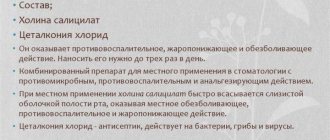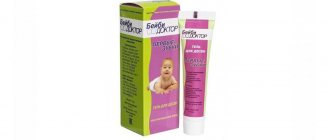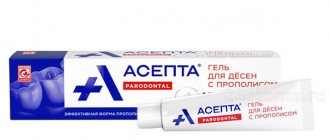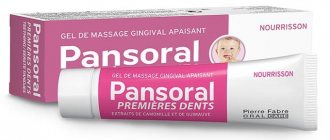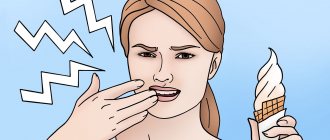Teething is a difficult period for babies and their parents. Every child experiences itching, pain and other unpleasant sensations at this time. And, of course, mom and dad don’t stand aside, trying to facilitate the appearance of the first teeth as much as possible by applying special gels for children’s gums, massage and other activities.
Let's figure out how to determine that your baby has started teething. Let's find out how to reduce discomfort.
Signs of teething
Most often, the first teeth appear at the sixth to eighth month, but in some babies the incisor may emerge as early as four months or, conversely, teething will be delayed for six months. All this is quite normal for a healthy little organism.
Since the tooth literally needs to cut through soft tissue to appear, the first symptoms will be redness and slight swelling of the gums in this place. In addition, the following symptoms may indicate the rapid eruption of the first teeth:
- Increased amount of saliva.
Over the course of a few weeks, you may notice that drool is dripping and even leaking from your mouth - this is normal during the teething period. - Itchy gums.
The tooth that is preparing to appear irritates the gums, causing itching and unpleasant pain. The child, trying to reduce discomfort, more often puts toys and pacifiers, various other objects and his hands into his mouth. - Appetite and sleep disturbances.
Unrelenting itching prevents the child from falling asleep and prevents him from eating properly. - Heat.
Some children experience an increase in temperature during this period; be careful; if the fever does not subside for more than two days, consult a doctor. - Stool disorder.
Diarrhea often accompanies the appearance of the first teeth, but you should also be very careful with it. If it intensifies, is too intense, or lasts more than two days, or is accompanied by a change in the color and smell of the stool, be sure to tell your doctor. - Symptoms of ARVI.
Since a cutting tooth causes inflammation in the oral cavity, it is quite logical for a runny nose and cough to appear. The main thing is not to confuse these symptoms with a real disease.
What can the patient do after removal?
To help the wound heal, the patient must take steps to prevent secondary infection. To do this, immediately after the intervention you need to accurately follow the general recommendations of the dentist.
- Press the cotton swab placed in the hole firmly with your teeth. This is important to stop bleeding and blood clot formation.
- For the same reasons, you should not eat or drink for 3 hours.
- Once a clot has formed, it is necessary to exclude the possibility of injury and removal. Do not rinse your mouth vigorously, inspect the wound with your fingers or a toothpick, smoke, drink alcohol, hot foods and drinks, or solid foods.
- Visits to the fitness center, sauna, and beach should be excluded for several days. Physical activity and overheating can lead to complications.
How to make teething easier
While the teeth are just getting ready to appear, the baby experiences a lot of unpleasant sensations, which, of course, causes a lot of trouble for the parents. During this period, the child needs care and affection, as well as plenty of fluids. It is recommended that infants be breastfed more often, and children on artificial nutrition should be offered more warm water.
There are many ways to relieve discomfort. Two most popular:
- Give your child special teethers - these are soft silicone toys filled with liquid. Cool the toy slightly in the refrigerator before use. This will help relieve swelling and reduce pain. The textured surface of the teether will give the baby the opportunity to thoroughly massage and “scratch” the gums. The bright design of the toy will attract attention to it and amuse the child.
- Use topical medications - pain-relieving gels and ointments for gums, designed specifically for children. These remedies act very quickly and help the child forget about discomfort for several hours.
Treatment methods
Individual therapeutic regimens are selected for each patient. The specialist takes into account the general well-being of the patient, the nature of the pathology and the severity of symptoms. The main methods of therapy are divided into local and systemic. In the arsenal of local treatments, dentists have: rinses, local gels or medicated toothpastes.
Sometimes remedies that act locally are not enough. In this case, the dentist or orthodontist may prescribe systemic medications. These can be: antibacterial, antifungal agents, antihistamines, immunomodulators, vitamin-mineral complexes. And in this review we will look at the best products for gums in the form of gels and rinses.
The effectiveness of baby gels for gums, how to use them when teething
Before buying this or that gel, consult your doctor to be sure of the safety and effectiveness of the product. Be sure to read the instructions before first use.
Basic rules for using gum gel when teething in a child:
- Apply the gel using a sterile cotton swab or very carefully with clean fingers.
- The product must be rubbed in slowly in a circular motion.
- Remember that a very small amount of gel is enough. Do not overdo it.
- The product can be used no more than four to five times a day, with a minimum interval of four hours between applications.
- Gels should only be used in cases of severe pain or discomfort. Usually the most painful teeth are the first two incisors and those that appear in the second year of life.
Types of inflammation and possible symptoms
There are two main types of inflammatory processes in the gums:
Gingivitis. This is a shallow inflammation of the gums, in which the periodontal joints are not affected. Most often this means inflammation of the gum area between two adjacent teeth. Moreover, this pathology is not dangerous for the teeth themselves. It does not cause their mobility.
Periodontitis. With this pathology, inflammation spreads to tissues that are located deep (bone structure, tooth roots). In this case, periodontal pockets often form. They accumulate food particles and soft plaque, which over time aggravates the situation.
With periodontitis, decay processes often occur, and the teeth become very mobile and there is a high risk of their loss. Both diseases can occur locally or affect the entire periodontium. A limited local inflammatory process most often occurs against the background of injury. General inflammation is usually caused by other negative factors.
It is quite easy to recognize gum inflammation by the following symptoms:
- hyperemia, tissue swelling;
- increased sensitivity of periodontal tissues;
- the appearance of bleeding;
- loose gums;
- bad breath.
If periodontitis is advanced, then the appearance of purulent discharge and a feverish state is possible. With ulcerative gingivitis, ulcers appear on the surface of the soft tissues. Atrophic gingivitis leads to exposure of the tooth necks. This in turn makes teeth more sensitive to hot or cold food.
Gum massage during teething
Since drug treatment cannot be considered completely safe, you should try more moderate options first. We have already talked about one of them above - these are teethers. In addition to these, other measures can be taken. For example, switch to chilled food and drink. This will help reduce the discomfort a little.
Gentle gum massage will also be an effective solution. Be very careful, since your baby's gums are very delicate, if you overdo it, there is a risk of increasing the pain. Therefore, you should approach massage wisely and with balance. And most importantly, with full knowledge of the methodology.
The massage consists of three main stages:
- Preparation.
If you decide that you will massage your gums with your finger, you need to trim your nails well, rinse thoroughly, and disinfect. It is very important to get rid of any dirt on your hand. But since this is quite difficult, there is a simpler and more convenient option - use special finger pads or napkins. They can not only massage your gums, but also gently clean your first teeth of food debris. Wet wipes "ASEPTA BABY" from 0 to 3 years help reduce pain during teething, effectively cleanse the oral cavity of food debris, and reduce the risk of inflammation. Each napkin is individually packaged; when using, you do not need to rinse your mouth with water. So you can have a massage not only at home, if necessary. Place the napkin on your finger, now you can proceed directly to the massage itself. - Massage.
Both infants and older children need to move massage movements from the edges of the disturbing areas to the site of eruption. Lightly rub the gums, stroke or apply a little pressure. All these movements can be combined. Watch your baby's reaction and choose the option he likes best. You don’t have to worry that you won’t be able to reach all the places; the soft fibers of the finger napkin will help you massage hard-to-reach areas. Remember that the procedure should be carried out only where the roots of the teeth are. There is no need to massage the eruption site itself, as this can worsen the child’s condition, cause discomfort and make it difficult for the tooth to emerge. - Hygiene.
As early as six months, you can accustom your child to the need for daily oral care. At this time, it is already recommended to use a special children's brush instead of a finger napkin, as well as toothpastes intended for children. For example, ASEPTA BABY paste, made on the basis of plant extracts. This product does not contain resin or abrasive substances, so it is excellent for newly erupted baby teeth that are still fragile. The paste has a pleasant taste, which will make the cleaning process more enjoyable. At first, watch the cleaning, and when the child grows up, he can do everything on his own.
Teething massage is an effective procedure that can not only reduce discomfort, but also reduce the use of medications. But it is very important to be extremely careful when performing a massage, both for infants and older children. Babies' gums are much more tender than those of adults. But if you do everything correctly, then after a fairly short time you will notice that the baby has become more comfortable, he has calmed down, and the teething itself is faster and easier.
You may also be interested in
CHILDHOOD
Finger wipes from 0 to 3 years ASEPTA BABY
For gentle oral hygiene of babies and massage of gums during the eruption of the first teeth
More about the product
CHILDHOOD
Children's gel toothpaste from 0 to 3 years ASEPTA BABY
Designed for gentle care of baby's gums and baby teeth
More about the product
Dentol baby 7.5%
This children's gum gel is used by many parents. It has an immediate anesthetic effect. Its main substance is benzocaine. The composition also includes additional ingredients. The drug is manufactured in Canada. Due to its liquid consistency, it has a quick cooling effect. Available in the form of a small tube with a narrow, comfortable neck. The taste of the ointment is sweetish and pleasant. To help the little one sleep peacefully, it is used at night. The analgesic effect does not last long. The drug is applied in small doses, no more than a grain of rice.
In addition, the medicine relieves toothache in childhood. It is used for pain relief during dental treatment, as well as for aphthous stomatitis and minor lesions of the oral mucosa.
Folk remedies
In addition to what has already been listed, you can turn to traditional methods. There are a huge number of them. We offer several popular options:
- Ice. Wrap an ice cube in a soft, clean cloth and gently rub it over your gums. Don't stay in one place. Make sure that the ice itself does not come into contact with the gum under any circumstances. Instead of ice, you can use a chilled terry cloth. Wet it, keep it in the refrigerator and let your baby chew it a little.
- Honey. Before using it, make sure your child is not allergic. To relieve pain, you need to gently rub a little honey into your gums. This will help the baby sleep.
- Soda solution. To relieve teething pain, prepare a solution: dilute one teaspoon of baking soda in a glass of warm water, and then lightly massage your gums with a cloth soaked in the solution.
- Chamomile. This plant has good anti-inflammatory properties and can be used in many ways: making tea or making compresses. For severe pain, it is recommended to use chamomile oil; it should be gently rubbed into the cheek near the place where the tooth erupts.
- Clove oil. This remedy helps relieve acute pain and reduce inflammation. To avoid burning your baby's tender gums, clove oil must be diluted in almond or sunflower oil.
- Tea made from lemon balm, lavender and chamomile. This soothing drink can be drunk with almost no restrictions by both mother and baby.
- Sage tea. The product helps not only relieve pain, but also improve gum health.
- Cold fruits and vegetables. Since ancient times, the process of teething has been facilitated with the help of chilled food. To relieve swelling, give your child cold pieces of carrot or apple.
Pansoral
With a dental gel like Pansoral, relief comes quickly. It soothes gum tissue with medicinal plant extracts. This product is natural and has a mild effect. It does not have a pronounced effect in eliminating pain. Characteristics:
- Consists of healing extracts of plants such as saffron and chamomile with the addition of marshmallow root.
- A number of additional ingredients have a soothing effect on inflamed areas of the gums.
- The drug is used when the pain is not severe.
The ointment is applied in small portions and rubbed into the mucous membranes with massaging movements. The drug is approved for use from 4 months of age. Manufacturer: French. In addition to the anti-inflammatory effect, the gel can have an antiseptic effect. Thanks to marshmallow extract, a protective film appears on the gums. This speeds up the tissue repair process. Regular use of this product gives good results. Overdose is excluded.

